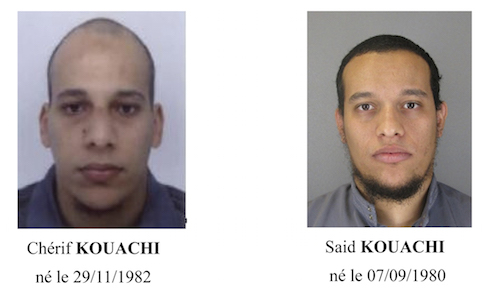By Mohammed Ghobari
SANAA (Reuters) - One of two brothers suspected of carrying out the deadly shooting at a French satirical weekly met leading al Qaeda preacher Anwar al Awlaki during a stay in Yemen in 2011, a senior Yemeni intelligence source told Reuters on Friday.
U.S. born and web-savvy, Awlaki was seen as an influential international recruiter to the al Qaeda movement and a prominent figure in Al Qaeda in the Arabian Peninsula (AQAP), the group's most active affiliate. He was killed in September 2011 in a drone strike widely attributed to the CIA.
U.S. and European sources close to the investigation said on Thursday that one of the suspects in the French attack, Said Kouachi, was in Yemen for several months training with AQAP.
The Yemeni source said Kouachi, 34, was among a number of foreigners who entered the country for religious studies.
"We do not have confirmed information that he was trained by al Qaeda but what was confirmed was that he has met with Awlaki in Shabwa," the source said, noting that he could have been trained in one of the large parts of Yemen not under the control of the authorities back in 2011.
The southern province of Shabwa is a lawless area where al Qaeda militants and the security forces have clashed in recent years. It was under al Qaeda's control in 2011 when mass protests forced long-ruling president Ali Abdullah Saleh to step down.
AQAP emerged as one of al Qaeda's most aggressive international affiliates and a direct threat to the United States, when it claimed responsibility for an attempt by a Nigerian man, Umar Farouk Abdulmutallab, to down a Detroit-bound airliner on December 25, 2009 with a bomb concealed in his underwear.
It said it was also behind a foiled plot to send two air freight packages containing bombs to the United States in October 2010.
Said and his brother Cherif, 32, are at the center of a huge manhunt in France following the killing of 12 people by Islamist gunmen at the offices of the satirical weekly newspaper Charlie Hebdo in Paris on Wednesday.
The two suspects are French-born sons of Algerian-born parents. Both men had been under police surveillance. Cherif was jailed for 18 months for trying to travel to Iraq a decade ago to fight as part of an Islamist cell.
There was no claim of responsibility for Wednesday's attack. However, a witness quoted by 20 Minutes daily newspaper said one of the assailants cried out before getting into his car: "Tell the media that it is al Qaeda in Yemen!"
BELOW THE RADAR
The Western intelligence sources said that after Said Kouachi returned to France from Yemen, both brothers appeared to have refrained from any activities that might have drawn the attention of French law enforcement or spy agencies.
They also said that in the months leading up to Wednesday's attack, the men were not treated as priority targets by French counter-terrorism agencies although Germany said later they were on a European watchlist.
The watchlist containing their names was put together by countries in the European Union's passport-free travel zone known as Schengen and used by border guards, police and other officials, German Interior Minister Thomas de Maiziere said.
"They were down for covert surveillance," de Maiziere was quoted as saying in an advance extract from an interview due to be aired on German public broadcaster ARD on Sunday.
U.S. government sources said both Said and Cherif Kouachi were listed in two U.S. security databases - a highly-classified database, containing information on 1.2 million possible counter-terrorism suspects, called TIDE, and the much smaller "no fly" list maintained by the Terrorist Screening Center, an interagency unit.
ABC News reported that the brothers had been listed in the databases for "years."
Some investigators believe Awlaki's death could have contributed to the brothers' decision to lie low, but other investigators say that it was too early to reach such a conclusion.
One of those killed in the Paris attack was Charlie Hebdo's top editor, Stephane Charbonnier, who drew cartoons under the rubric "Charb."
Last spring, "Inspire," an English-language online magazine published by AQAP, featured a "Wanted dead or alive" graphic which included Charbonnier's name and photograph. There was no immediate evidence that the graphic actually inspired the Paris attack.
(Additional reporting by Mark Hosenball in Washington and Michelle Martin in Berlin; writing by Rania El Gamal; editing by Alison Williams and Philippa Fletcher)
